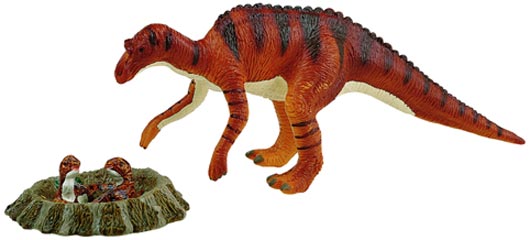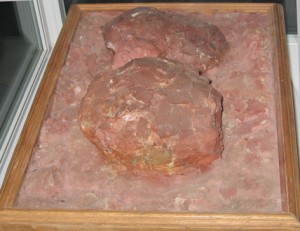Egg-Laying Dinosaurs Doomed Whilst Mammals Live-Birth Reproduction Strategy Triumphed
A team of scientists based in Switzerland have used computer models comparing how dinosaurs grew from a hatchling into an adult with the growth rate of mammals to suggest that the dependence on egg-laying was a factor in the demise of the Dinosauria. They have added a new twist to the dinosaur extinction theory.
Dinosaur Extinction Theory
Given the physical limitations imposed on the size of hatchlings, dictated by the physical limits of the eggs they hatch from, many dinosaur species had to grow from babies just a few tens of centimetres long into thirty metre and forty tonne giants. Small, baby dinosaurs having to grow quickly could not compete against mammals that gave birth to much better developed mammalian offspring who could benefit from being suckled by their mothers.
The dinosaurs became extinct approximately sixty-six million years ago, the exact reasons for the extinction of the Dinosauria along with about seventy percent of all terrestrial life at the end of the Cretaceous are still debated, however, within a few million years, life on Earth had recovered and the mammals were rapidly diversifying to fill many of the niches in the ecosystem that were once occupied by dinosaurs. A team of researchers from the University of Zurich (Switzerland), have used a complex, mathematical model to plot how mammals with their different strategy over reproduction may have gained the ascendancy over those type of dinosaur that survived until the very end of the Mesozoic.
Did the Dinosauria’s Reliance on Eggs Lead to their Demise?
Picture credit: Everything Dinosaur
To view models and figures of extinct non-avian dinosaurs and other prehistoric animals: Safari Ltd Dinosaur Models.
In press releases concerning this new research, detailed in the scientific journal “Biology Letters”, it has been suggested that the mammals won a sort of evolutionary victory over the egg-laying dinosaurs but this does very probably, over simplify the complex environmental factors that were influencing evolution at this crucial time in our own species’s history. Had the dinosaurs not died out, it is unlikely that there would be the diversity of mammal types around today and it could be argued that the primates, including our own species – Homo sapiens may not have evolved at all.
Ontogenic Studies
The Zurich based scientists looked at how the two sorts of animals (mammals and dinosaurs) grew, they studied the ontogenic properties of typical dinosaurs and mammals that were alive around sixty-six million years ago. As dinosaurs hatched, they would have had to compete for food with other dinosaurs as well as mammals, whilst the offspring of mammals had their mother’s milk to sustain them. In addition, dinosaurs had to grow very quickly, for example a baby titanosaur (long-necked dinosaur), may have had to put on more than one kilogramme of body weight a day – a rate of weight gain not seen in the much smaller mammal genera around at the time.
As baby dinosaurs grew, the young animals would have had to compete in several size categories for food, including adults of other animal groups. This, the scientists claim put the Dinosauria at a distinct advantage and this may help explain why they died out but the majority of mammals did not.
Those niches in the food chain for small and medium-sized animals were already “occupied”, with the intense competition for depleted food reserves after an extraterrestrial impact, volcanism and climate change leaving no room for the dinosaurs.
Being relatively small, as in the case of the Mammalia at the end of the Cretaceous may have been key to their survival, the fossil record suggests that immediately after the extinction event there were very few terrestrial animals larger than a Labrador dog (around 25 kilogrammes). Some mammals also lived in burrows and bred very rapidly, these factors too could have assisted in the Order’s ultimate survival.
A Fossilised Dinosaur Nest showing Eggs
Picture credit: Everything Dinosaur
The Swiss team claim that smaller mammals were able to cope with the post-extinction environment much more effectively than their egg-laying competitors and this led them to evolve and diversify very rapidly in the Cenozoic, rapidly occupying all the niches once held by the dinosaurs.
The team aimed to answer the question using their mathematical model as to why the Dinosauria died out yet the Mammalia survived? Could adult body mass, and an egg-laying reproduction strategy hold the answer?
Contrary to popular belief, compared to their eventual adult size, many dinosaurs hatched from comparatively small eggs. The largest dinosaur eggs known in the fossil record are believed to have been laid by titanosaurs (long-necked dinosaurs), these eggs are roughly football-sized and from a hatchling, perhaps less than one metre long and weighing a few kilogrammes, these animals would grow to become a forty metre long, forty thousand kilogramme adult animal.
The discovery of some bizarre, egg-shaped structures by construction workers in Chechyna has recently been featured in a number of media outlets. The egg-shaped objects, some more than a metre in circumference were believed by some observers and academics to be the fossilised remains of a dinosaur nesting site. However, palaeontologists have cast doubt over the authenticity of these claims as the structures are simply “too big” to be dinosaur eggs.
To read more about this story: World’s Largest Dinosaur Eggs – The Facts are Scrambled.
The size of an animal that can hatch from an egg is governed by a number of factors. Firstly, the egg shell has to be thin enough to allow gaseous exchange between the external environment and the embryo inside the egg. The egg shell has to be thin enough to allow a baby to hatch, to break out of the egg. If dinosaur eggs were much bigger, then the egg shell surrounding them would have to be much thicker to support the weight of the liquid and the embryo inside. The egg shell would have to be many times thicker to accommodate this extra weight and therefore, too thick for a baby to break out of. If the egg shell remained thin as egg size increased then a great many eggs would never hatch as the eggs would crack and split long before the embryo had developed enough to be able to hatch. Egg size is also limited by the ability of the female to store eggs, to divert enough calcium to permit the formation of egg shell in her body and to allow the passing of eggs via the oviduct so they can be physically laid.
The scientists compared the growth rate of the largest land mammal today, the African elephant (Loxodonta africana) to that of a typical Late Cretaceous titanosaur, the largest type of dinosaur around at the very end of the age of reptiles. The Swiss team suggested that a titanosaur hatchling was 2,500 times lighter than an adult titanosaur, whilst the African elephant calf was only twenty-two times lighter than its mother.
Cretaceous Mass Extinction Event
Many papers have been written on the Cretaceous mass extinction event. Egg-laying animals may have been more vulnerable to climate change and this could have been a factor in the demise of the Dinosauria. However, monotreme mammals (mammals that lay eggs and give birth to very underdeveloped young), did survive the extinction event. Birds too, survived and they all lay eggs (classified technically as avian dinosaurs). Body size and the amount of resources needed to sustain a viable breeding population may be a more significant factor in the lottery of life that occurs during an extinction event. The scientific paper does not help to explain how the pterosaurs or the marine reptiles died out. Some marine reptiles were viviparous, able to give birth to live young, yet these animals too, went the way of the dinosaurs.
The dinosaurs reliance on an egg-laying reproduction strategy may well have played a role in their eventual demise, but during the Late Cretaceous extinction event all sorts of terrestrial animals became extinct – reptiles, mammals, amphibians and birds. Thanks to a few types of mammals surviving into the Cenozoic we have the great diversity of mammals seen today. Within ten million years or so, the main groups of modern mammals had evolved including those prosimians that were to lead eventually to our own species.
Visit Everything Dinosaur’s award-winning website: Visit Everything Dinosaur.







Leave A Comment